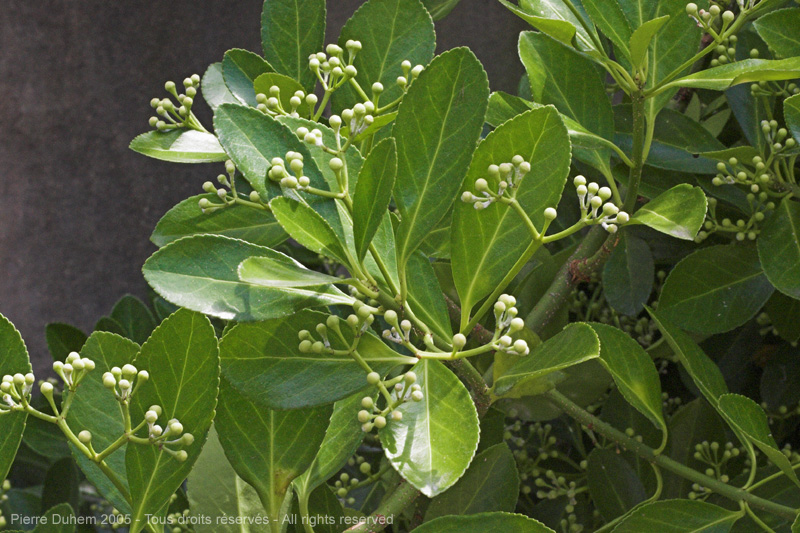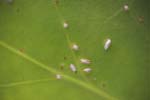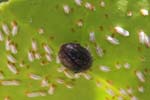

Euonymus japonicus

In the Montmartre cemetery, the Euonymus japonicus (Japanese euonymus) is
frequently used to decorate tombs. On the other hand, it is often the prey of
many insects...
frequently used to decorate tombs. On the other hand, it is often the prey of
many insects...
Click below on the thumbnails to display a bigger picture.
Click again on the picture to come back.
Click again on the picture to come back.
Here, a colony of Euonymus scale (Unaspis euonymi) which attacks massively some trees, so massively that leaves can fall in summer.
On the last picture, one can distinguish between males (whitish elongated form) and females (light brown scale).
This young branch is not yet severely attacked.
This young branch is not yet severely attacked.
Things are already worse for this one. On can see the greyish hard shell-like covering of old females and the crawling nymphs which are looking for a place to rest and feed. Some males already began the production of their waxy protective covering. Young females also began to produce their light brown pear-like shell.
One can also see on some of those pictures the young nymphs, with their orange color.
Such scale colonies can't remain unnoticed. Predators exist also for those scales.
A Lady beetle (Chilocorus sp.) and its remarquable larvae.
Such larvae sometimes take curious positions.
The last larva of the row could be parasited by the little Hymenoptera which lies on its back.
The last larva of the row could be parasited by the little Hymenoptera which lies on its back.
Here, pupae, where the larvae transform to produce the imago.
The armoured scales we saw above were not the only ones. The euonymus was also attacked by soft scales (Eulecanium sp.).
As those scales produce honeydew, ants stay around to get it...
Against all this, the Euonymus could nevertheless blossom. Its nectar attracted other visitors...
Coleoptera, which seem to apreciate...
A lady beetle Chilocorus sp. gets something to drink after hunting scales.
Flies with enormous trumps...
Other lady beetles, coming merely for the nectar.
Two different forms of the two-spotted lady beetle (Adalia bipunctata).
Two different forms of the two-spotted lady beetle (Adalia bipunctata).
Two rose lady beetles (Oenopia conglobata) and a seven-spotted one (Coccinella septem-punctata).
A tiny hymenoptera on the left. Then ants which feed directly on flowers (one could think they always need some go-between)...
In the Syrphids, two splendid hoverflies (Volucella zonaria), then a small Paragus sp..
After those mating flies, two more hoverflies: Myathropa florea and Eristalis sp.
To end the show, some more hymenoptera: Apis mellifera, the bee-wolf (Philanthus triangulum) and a Cerceris sp.
All pictures taken in May, June and August 2005.
All rights reserved.
Last update: February 2023
Questions and comments are welcome.
Back to the Feature Gallery
All rights reserved.
Last update: February 2023
Questions and comments are welcome.
Back to the Feature Gallery


















































